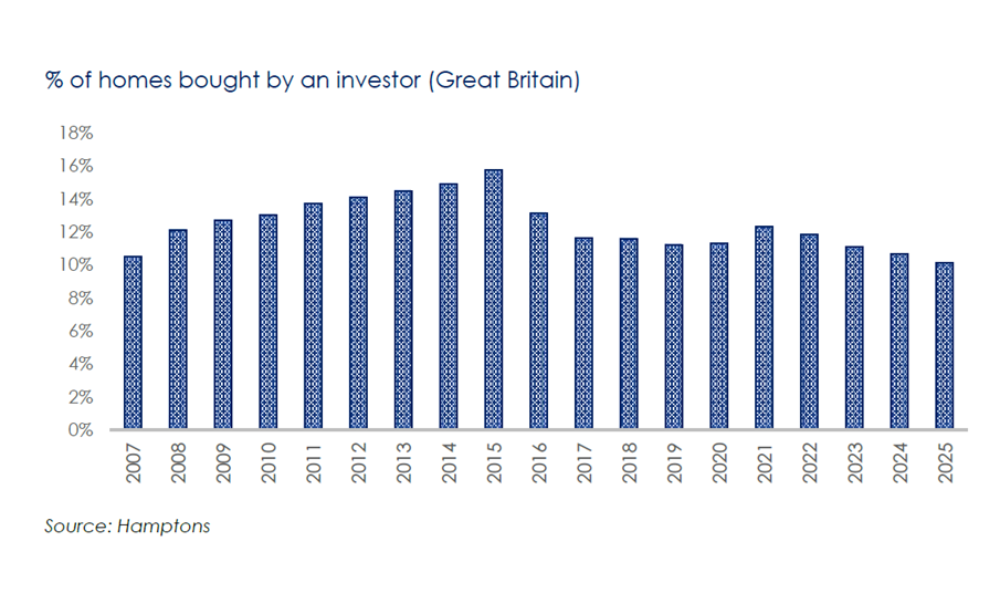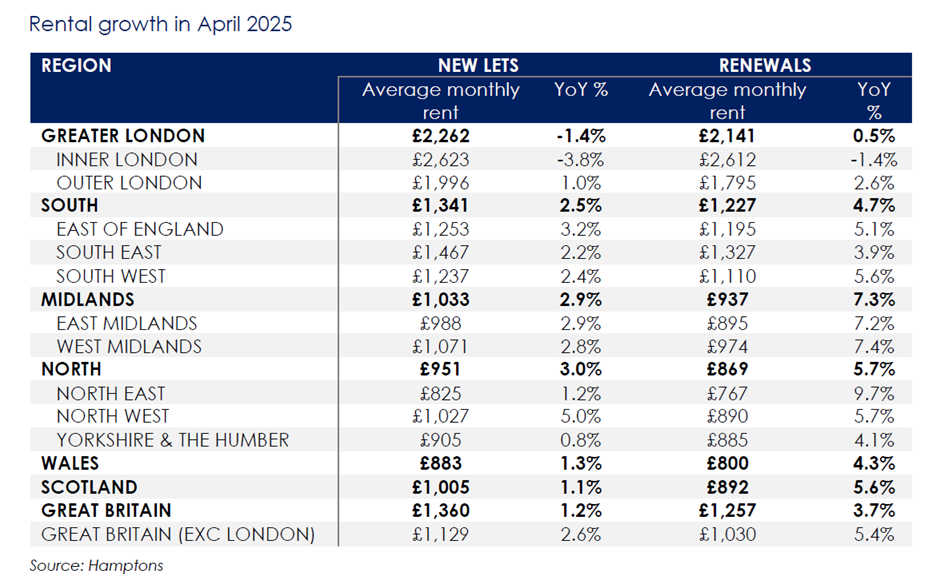Surging costs drive investors away from London and the South

The North of England and the Midlands have emerged as the new focal points for buy-to-let investors, driven by a combination of lower purchase prices and stronger rental yields, according to the latest Hamptons Monthly Lettings Index.
From January to April 2025, 39% of all buy-to-let transactions took place in the North or Midlands—up from 34% in 2022 and 24% in 2007. In contrast, just 43% of purchases occurred in London and the southern regions, down from 53% a decade earlier. The remainder of activity was spread across Wales and Scotland.

The trend has been shaped by rising mortgage costs and the increase in the stamp duty surcharge to 5%, which has weighed more heavily on the pricier southern markets. Investors in the North and Midlands spent an average of £150,480 on properties — nearly half the £292,240 paid by buyers in southern England — saving approximately £11,190 in stamp duty.
Overall, buy-to-let investment has declined nationally. Investors accounted for 10% of property purchases across Britain in the first four months of the year, down from 11% last year and 16% in 2015.

The North East stands out as the only region to see a rise in buy-to-let activity over the last decade. Landlords there bought 28% of all homes sold so far this year, compared to 23% in 2015. The region also offers the highest average rental yield in the UK at 9.3%, well above the national average of 7.1%.
Wales and London have seen the steepest declines. Investor activity in Wales dropped to 6%, down from 16% in 2015, while London’s share fell to 8%, half the proportion recorded a decade ago. For each new buy-to-let purchased in the capital, there are now more than three being bought in the North West.
Scotland has seen buy-to-let activity fall to 5% of sales this year, down from 10% in 2015, amid stricter rental regulations and price caps.
Despite lower overall investment, demand remains robust in several northern areas. Nine of the 10 top local authorities for buy-to-let activity since the stamp duty surcharge was raised in November 2024 are located in the North or Midlands. Redcar and Cleveland leads the list, where half of all property purchases were made by landlords. The typical buy-to-let in the area cost £70,300 and attracted a £3,515 stamp duty bill.
Most of these top-performing areas also reported gross rental yields exceeding the national average, offering investors better returns to offset rising expenses.
More London-based landlords are now buying outside the capital. This year, 65% of them did so, compared to 41% ten years ago and just 24% in 2007. The shift accelerated after the 3% surcharge on second homes was introduced in 2016, and mortgage interest tax relief for higher-rate taxpayers began to be reduced.
This year, 18% of London investors acquired properties in the North, up from just 5% a decade ago. A growing share of buy-to-let transactions are also delivering double-digit yields—23% so far in 2025, up from 17% in 2024 and 9% in 2016—reflecting the shift towards higher-yielding locations.
A typical buy-to-let property priced at £198,550 generates £1,985 in additional annual rent for each percentage point rise in gross yield. In the North East, this could mean rental income of £18,400 per year—62% more than the average income from a comparable investment in London. However, long-term capital gains have typically been stronger in the capital.
Rental growth trends
Rent increases on tenancy renewals are easing amid falling mortgage rates and slower rental growth in the wider market. In April, 55% of landlords raised rents on renewed leases, down from 59% a year earlier.
For nearly two years, rents on renewals have been rising faster than those on new tenancies, as landlords sought to recover higher costs. In April, the average renewal rent reached £1,257 per month, up 3.7% year-on-year. By comparison, new let rents increased by just 1.2% over the same period.
Despite gains in renewal rents, a gap remains. Renewals have risen by 28% over the last five years, while new lets have climbed by 36%. This results in tenants who renew their leases paying £103 less per month on average than those moving into new properties.
In London, rents on new tenancies fell by 1.4% in April year-on-year, marking the fifth consecutive monthly drop. Renewal rents in the capital rose by 0.5%, and only 23% of landlords increased rent upon renewal, down from 37% in April 2024.

“Buy-to-let investment is gradually grinding to a halt in some markets where higher purchase and mortgage costs take their toll,” said Aneisha Beveridge (pictured), head of research at Hamptons. “However, while new landlord purchases remain well below long-term averages, some investors have been looking further afield for new opportunities.
“One of the main ways landlords are trying to mitigate against higher stamp duty and mortgage costs is by seeking better-yielding and cheaper properties, increasingly in Northern England.”
Beveridge added that the current trajectory could see most buy-to-let activity concentrated in the North and Midlands by 2033. However, this shift could lead to a drop in Treasury revenues and potential supply issues in the South if investment fails to keep pace with demand.
Want to be regularly updated with mortgage news and features? Get exclusive interviews, breaking news, and industry events in your inbox – subscribe to our FREE daily newsletter. You can also follow us on Facebook, X (formerly Twitter), and LinkedIn.



